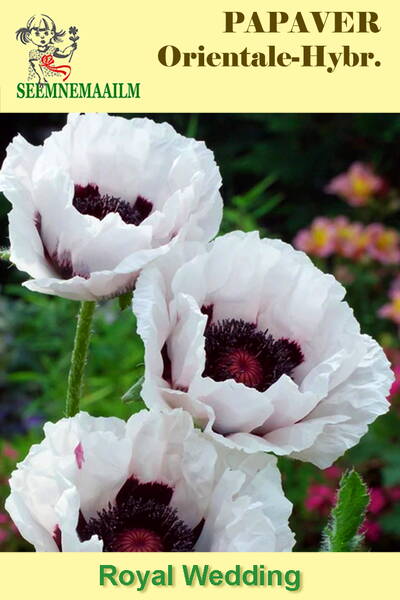Large, pure white flowers with a black center.
A perennial plant of the Papaveraceae family.
Height of flowering plant: 80 cm.
Flower colour: pure white with a black center.
Foliage: rough, pubescent, dissected.
Growth type: erect.
Natural flowering period: May - June.
Winter hardiness zones: Z3 - Z8.
Soil requirements: dry, well drained.
1.0 g = 3800 seeds.
Propagation: Perennial poppies are propagated by seeds, root cuttings, and green cuttings. Seeds are sown in early spring and germinate within two weeks. Seedlings are pricked out immediately after the appearance of one or two true leaves and transplanted to a permanent location. Cuttings are taken from small rosette-shaped side shoots that grow in spring or late summer. They are planted in moist beds and trained in place. Rooting occurs 2-3 weeks after planting and they can be grown for another 1-2 years. They are sensitive to transplanting and are best transplanted directly to their permanent location.
Cultivation: Perennial poppies are frost-hardy plants, easy to grow, and undemanding. They prefer open sunny areas but can tolerate some shade. They grow in any garden soil. They respond well to organic and mineral fertilizers, which enhances their flowering and results in larger flowers.
Poppies absolutely cannot tolerate stagnant water—their roots rot. Like other taproot plants, they do not tolerate transplanting as adults during the growing season. Small specimens may survive transplanted with a root ball. In any case, replanting should be done in midsummer, after flowering and the leaves have faded. They are propagated primarily by seed. These are sown in a permanent location after harvesting in the fall or spring. If replanting is necessary, it is best to do so when the seedlings have only developed a couple of leaves.
Uses: Perennial poppies are suitable for mixed borders, rockeries, and beautiful in groups. Bouquets of poppies will decorate any room. Unfortunately, they don't last long in water. Poppies are best cut in the morning, when the buds are bursting. Hold the cut over a flame for a few seconds to prevent the sap from clogging the stems. After this, place the flowers immediately in a vase of water.
Bot. syn.: Papaver bracteatum.
Poppies were a favorite flower of Claude Monet, Renoir, and Van Gogh. In Monet's famous garden in Giverny, France, which remains much as it was during the artist's lifetime, oriental poppies grow alongside tall bearded irises and daisies.
As for poppies' notoriety as a source of narcotics, the oriental poppy doesn't support this reputation due to its lack of narcotic alkaloids. The oriental poppy is beautiful in every way—the feathery leaves with stiff pubescence, the sheath-like buds, the crumpled petals reminiscent of delicate silk fabric...












